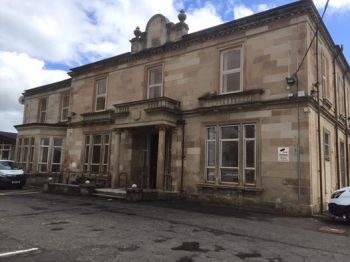
Little Udston farm was situated right at the end of Hamilton, just next to Blantyre and is not to be confused with the Udston area of Burnbank. The farm was a working one with vast open spaces and a good panoramic view looking over Hamilton. Today the land where Little Udston Farm was situated, is at the top of Hillhouse, undeveloped between Fleming Way & Townhill Road.

The earliest record for Udston that I have found so far, is on the 1654 map of Scotland, where it has been written as Utoun and the first house or dwelling was built between 1662 and 1773. By the 1892 Map the larger house no longer appears, so I assume it was demolished by then.

Little Udston Farm was part of the larger estate of Udston House, which was owned by Lewis Potter. Lewis Potter, who was one of the directors of the City of Glasgow Bank until the disaster occurred, in the recession of October 1878. He borrowed large sums of money for his land speculation. In the 1878 recession, the City of Glasgow Bank collapsed with debts of over £5 million. The directors were found guilty in January 1879 and Lewis Potter was sentenced to 18 months’ imprisonment.

Udston was a two Farm Steadings belonging to different proprietors & sharing the same name without any distinction whatever. The properties, respectively, of Mrs Jackson & Mr. Sinclair. The road to these Steadings is supported by the Parish to the extent of the Lands of “Udston” belonging to “Udston House”.
In the year 1816 there is a Mr Jackson who is listed as the owner and he was still listed as the owner of Udston in the 11th of August 1846 as there was a story written about him in the Hamilton Advertiser on the (03/08/1918) when he was elected chairman for the collections of poor relief. On the 1816 map there seems to be a substantial house next to Mr Jackson’s name. This would confirm that this was the main Farm House and Little Udston at this time was a small part of the estate.
On the Udston estate there was four farm houses, two at the Little Udston, Udston Cottage and Udston House, Udston House which was further down in what is now the Udston council estate in Burnbank.

When the rich coal seams were discovered under the ground at Udston the little quiet farm became a really busy place with the opening of Udston Colliery and one of the entrance’s was situated right at the front of the farm and later a railway line that was used originally as a mineral line to Quarter, Eddlewood and Neilsland Collieries who transported their coal on it. The line was eventually extended to Strathaven. The Minerals rights were later owned by the trustees of the late William Jackson and now as well as having tenant farmers, William Dixon ltd & The Udston Colliery Company were also tenants on the farm.



During the lifetime of the farm there were many tenant farmers that worked the land and the last of the families that lived here was the Mains. John & Robert Main took over the Tenancy between 1905 & 1915 and the family worked her right up until the farm was bought by compulsory purchase by the council. Robert Main later moved from Little Udston Farm around 1930 and they moved to Auchintibber for a while then managed to buy another place Rowantreehill Farm Braehead Forth where he settled.
The council had originally planned to have 2 Apartment houses built on the Udston farm site, however as they believed that this would cause overcrowding and scrapped this idea.
The following report was published in the Scotsman on the 12th December 1934.
Hamilton Housing – No two apartment Dwellings at Udston Farm Scheme.
Following representations by the Department of Health for Scotland , Hamilton Town Council decided last night to accept a recommendation by the Housing Committee that no two-apartment houses be included-in the scheme of 900 houses at Udston Farm site , near Burnbank .
“The Department , in a letter to the Council , which was read at a meeting of the Housing Committee , expressed its strong conviction that it was not desirable to have any two apartment houses in the scheme .
They pointed out that . according to the 1931 Census returns , 63 per cent , of the houses in the burgh are of one and two apartments , and that , in addition , there is always great danger of overcrowding where two-apartment houses are allowed , and that if three-apartment houses were substituted it would greatly facilitate the efforts of the Council to deal with overcrowding ”
In the 1940s/50s, the council built there new 900 home housing estate on the land surrounding the farm and it is now known as Hillhouse.

We would like to thank Jim Cochrane for sending us his pictures of his Gran & Great Grandfather at Little Udston Farm & also to Paul Veverka of The Blantyre Project for pointing Jim in our direction.

I lived in Comrie Crescent from 1959. Remember when the farmers went away for a couple of days, and the locals decided they’d gone for good, despite a sheepdog chained to a kennel in the yard, and ransacked the yard for anything which could be moved. When the farmer returned the police were called in, and the search began for stolen goods. My mother hid a pick-axe head under the mattress till it all blew over, but a neighbour who’d lifted a load of paving stones got nicked. Must have been 1961-62. Farm was demolished soon after.
LikeLiked by 1 person
Thanks for Sharing your story Donald.
LikeLike